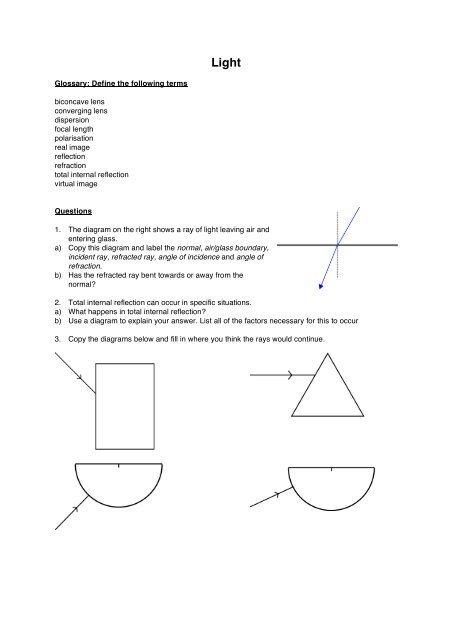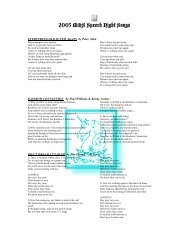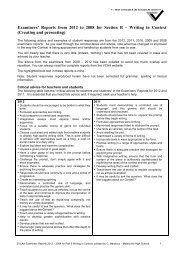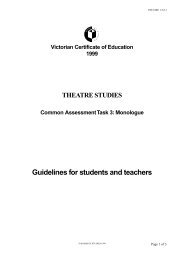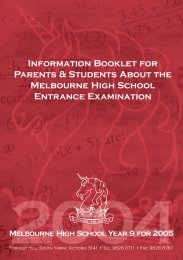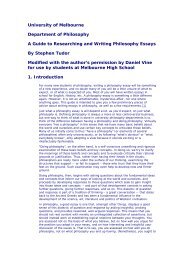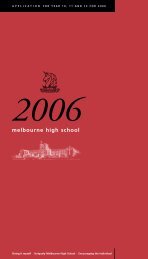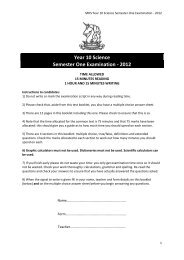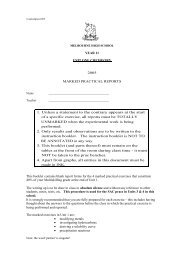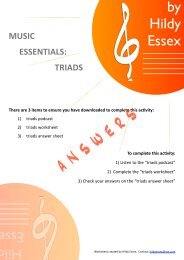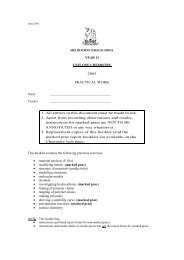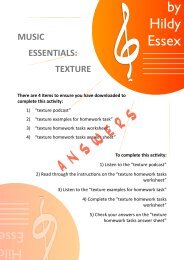Light revision worksheet
Light revision worksheet
Light revision worksheet
Create successful ePaper yourself
Turn your PDF publications into a flip-book with our unique Google optimized e-Paper software.
<strong>Light</strong><br />
Glossary: Define the following terms<br />
biconcave lens<br />
converging lens<br />
dispersion<br />
focal length<br />
polarisation<br />
real image<br />
reflection<br />
refraction<br />
total internal reflection<br />
virtual image<br />
Questions<br />
1. The diagram on the right shows a ray of light leaving air and<br />
entering glass.<br />
a) Copy this diagram and label the normal, air/glass boundary,<br />
incident ray, refracted ray, angle of incidence and angle of<br />
refraction.<br />
b) Has the refracted ray bent towards or away from the<br />
normal<br />
2. Total internal reflection can occur in specific situations.<br />
a) What happens in total internal reflection<br />
b) Use a diagram to explain your answer. List all of the factors necessary for this to occur<br />
3. Copy the diagrams below and fill in where you think the rays would continue.
4. If light bends away from the normal as it passes from material 1 into material 2, then:<br />
a) Draw a diagram to illustrate what is happening.<br />
b) Which of the materials is more optically dense<br />
c) In which material does the light travel faster<br />
d) Suggest some possibilities for what materials 1 and 2 could be.<br />
5. Copy the diagrams below and fill in where you think the rays would continue. Name the lens types<br />
shown.<br />
6. Draw a diagram to show how you could locate the focal length of a concave lens.<br />
7. Images can be described as real or virtual.<br />
a) Name the type of lens that produces a real image.<br />
b) How could you test if an image is real<br />
c) Must the object be close to or further away from the lens in order for this to occur Explain.<br />
8. List at least five devices that use lenses.<br />
9. Which type of lens only produces smaller, upright images<br />
10. Would a simple camera use convex or concave lenses Explain.<br />
11. List the colours of the spectrum. If light of all these colours is shone together, what would it<br />
produce<br />
12. Explain the meaning of dispersion. Give an example of a situation where you may have noticed<br />
this effect.<br />
13. Copy the diagrams below and fill in where you think the rays would continue. Name the mirror<br />
types shown.<br />
14. Copy and complete the statements below about the adding of coloured lights.<br />
a) red + blue → ………………….<br />
b) red + green → ………………….<br />
c) green + blue → ………………….<br />
d) green + red + blue → ………………….
15. Copy and complete the statements below about the adding of coloured inks.<br />
a) magenta + yellow → ………………….<br />
b) magenta + cyan → ………………….<br />
c) cyan + yellow → ………………….<br />
d) cyan + magenta + yellow → ………………….<br />
e) cyan + red → ………………….<br />
f) red + green → ………………….<br />
16. What colour would a green frog look under yellow light Would any type of light make it appear<br />
black Explain.<br />
17. If red light passes through a magenta filter, what colour emerges<br />
18. If a green filter is placed behind the magenta filter, what will the result be<br />
19. Gina and Clare decide to wear their new clothes to the night club. Gina looks stunning in her red<br />
top, blue pants and black shoes, and Clare is resplendent in her white top, yellow skirt and green<br />
shoes. The lighting inside the night club is nearly all red and blue. What would Ginaʼs and Clareʼs<br />
clothes now look like<br />
20. Bill and Ben are relaxing on a beach. Bill is wearing red-tinted glasses and Ben is sporting a<br />
yellow pair. A toddler named Emily runs past them in a wobbly fashion, wearing a white T-shirt,<br />
green shorts and magenta cap. Describe how each will see Emily.<br />
21. Describe the nature of a light wave.<br />
22. If you were to look at a light source through two polarising lenses, with one held at 90° to the<br />
other, what would you see Why<br />
23. A lucky seagull circling over the ocean spies a tasty morsel. Copy the diagram below and<br />
complete the path of the light rays to show how far below the surface the seagullʼs snack appears<br />
to lie, assuming that the surface is flat. Explain with the assistance of a diagram the effect that<br />
wave ripples on the surface would have on the way that the fish appears to the bird.<br />
24. Pigments are chemicals that absorb some colours of light and reflect others. The colour of the<br />
reflected light determines the colour of the object containing the pigment. Pigment X reflects<br />
mostly orange light with a little red and yellow, but absorbs all green, blue, indigo and violet light.<br />
Pigment Y reflects mostly green light, with some blue and yellow, but absorbs all other colours. If<br />
you dye a pair of your favourite socks in a mixture of X and Y, what colour will they become<br />
25. A liquid crystal display uses polarisation and reflection. Explain how a digit is formed.


